technical data FIAT TALENTO 2018 Owner handbook (in English)
[x] Cancel search | Manufacturer: FIAT, Model Year: 2018, Model line: TALENTO, Model: FIAT TALENTO 2018Pages: 232, PDF Size: 5.54 MB
Page 6 of 232
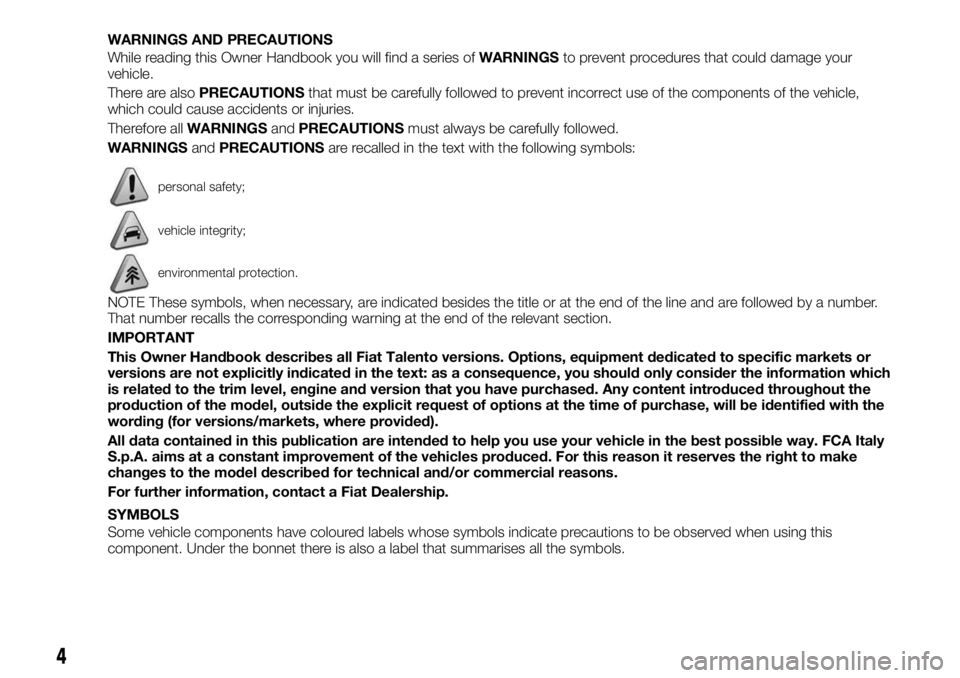
WARNINGS AND PRECAUTIONS
While reading this Owner Handbook you will find a series ofWARNINGSto prevent procedures that could damage your
vehicle.
There are alsoPRECAUTIONSthat must be carefully followed to prevent incorrect use of the components of the vehicle,
which could cause accidents or injuries.
Therefore allWARNINGSandPRECAUTIONSmust always be carefully followed.
WARNINGSandPRECAUTIONSare recalled in the text with the following symbols:
personal safety;
vehicle integrity;
environmental protection.
NOTE These symbols, when necessary, are indicated besides the title or at the end of the line and are followed by a number.
That number recalls the corresponding warning at the end of the relevant section.
IMPORTANT
This Owner Handbook describes all Fiat Talento versions. Options, equipment dedicated to specific markets or
versions are not explicitly indicated in the text: as a consequence, you should only consider the information which
is related to the trim level, engine and version that you have purchased. Any content introduced throughout the
production of the model, outside the explicit request of options at the time of purchase, will be identified with the
wording (for versions/markets, where provided).
All data contained in this publication are intended to help you use your vehicle in the best possible way. FCA Italy
S.p.A. aims at a constant improvement of the vehicles produced. For this reason it reserves the right to make
changes to the model described for technical and/or commercial reasons.
For further information, contact a Fiat Dealership.
SYMBOLS
Some vehicle components have coloured labels whose symbols indicate precautions to be observed when using this
component. Under the bonnet there is also a label that summarises all the symbols.
4
Page 9 of 232
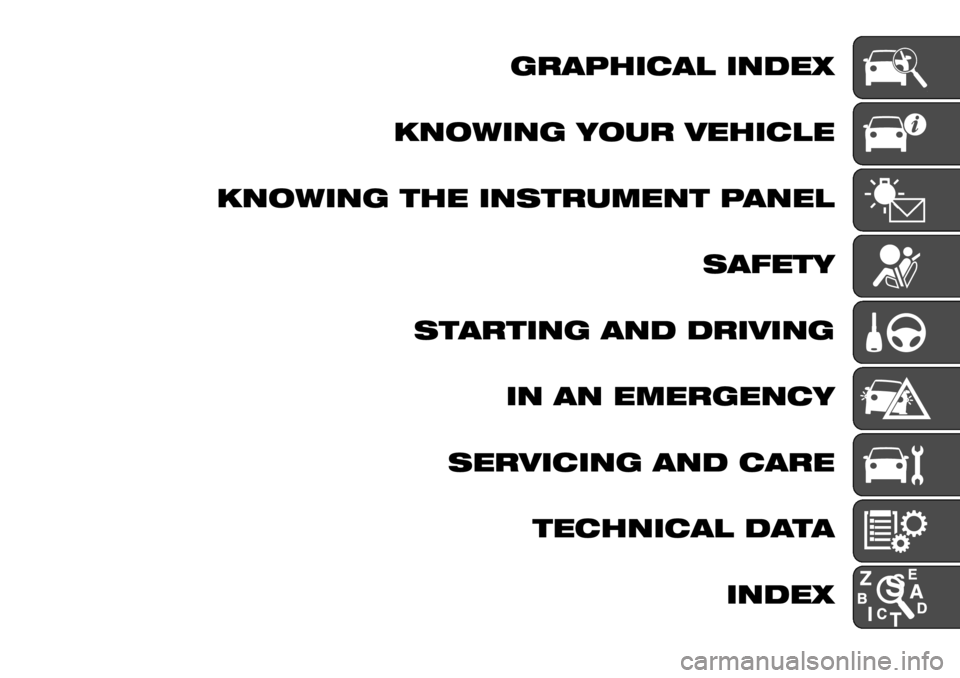
GRAPHICAL INDEX
KNOWING YOUR VEHICLE
KNOWING THE INSTRUMENT PANEL
SAFETY
STARTING AND DRIVING
IN AN EMERGENCY
SERVICING AND CARE
TECHNICAL DATA
INDEX
Page 11 of 232
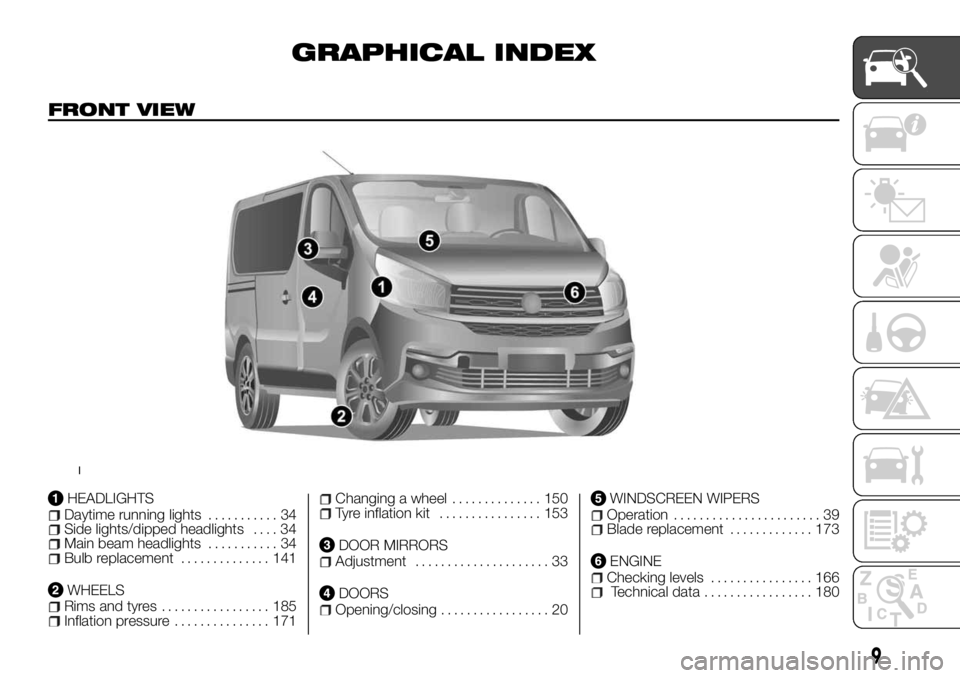
GRAPHICAL INDEX
FRONT VIEW
HEADLIGHTSDaytime running lights........... 34Side lights/dipped headlights.... 34Main beam headlights........... 34Bulb replacement.............. 141
WHEELSRims and tyres................. 185Inflation pressure............... 171
Changing a wheel.............. 150Tyre inflation kit................ 153
DOOR MIRRORSAdjustment..................... 33
DOORSOpening/closing................. 20
WINDSCREEN WIPERSOperation....................... 39Blade replacement............. 173
ENGINEChecking levels................ 166Technical data................. 180
1
9
Page 136 of 232
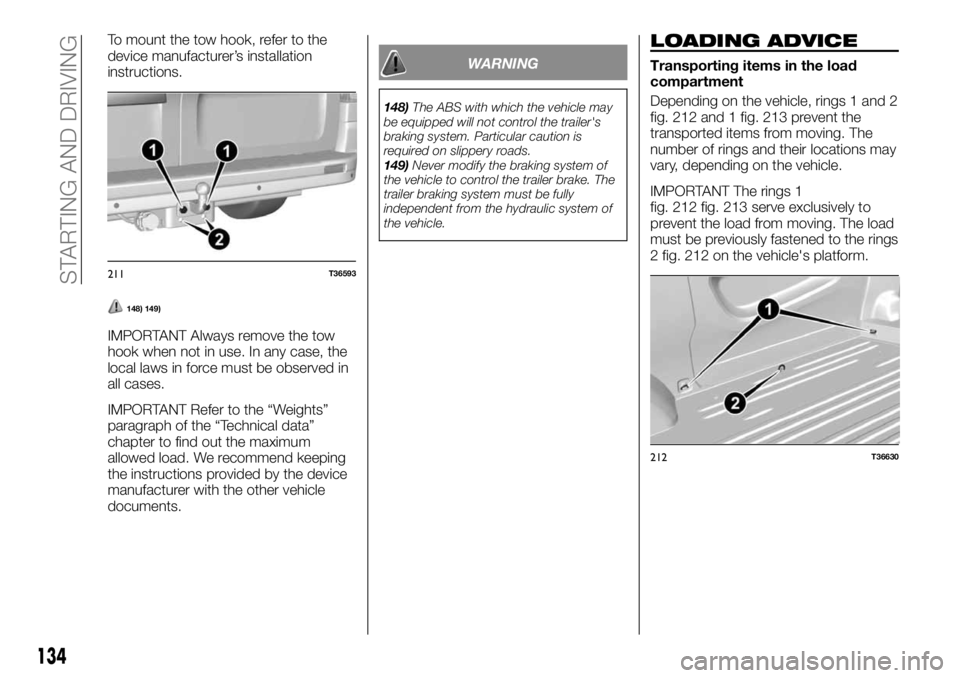
To mount the tow hook, refer to the
device manufacturer’s installation
instructions.
148) 149)
IMPORTANT Always remove the tow
hook when not in use. In any case, the
local laws in force must be observed in
all cases.
IMPORTANT Refer to the “Weights”
paragraph of the “Technical data”
chapter to find out the maximum
allowed load. We recommend keeping
the instructions provided by the device
manufacturer with the other vehicle
documents.
WARNING
148)The ABS with which the vehicle may
be equipped will not control the trailer's
braking system. Particular caution is
required on slippery roads.
149)Never modify the braking system of
the vehicle to control the trailer brake. The
trailer braking system must be fully
independent from the hydraulic system of
the vehicle.
LOADING ADVICE
Transporting items in the load
compartment
Depending on the vehicle, rings 1 and 2
fig. 212 and 1 fig. 213 prevent the
transported items from moving. The
number of rings and their locations may
vary, depending on the vehicle.
IMPORTANT The rings 1
fig. 212 fig. 213 serve exclusively to
prevent the load from moving. The load
must be previously fastened to the rings
2 fig. 212 on the vehicle's platform.
211T36593
212T36630
134
STARTING AND DRIVING
Page 163 of 232
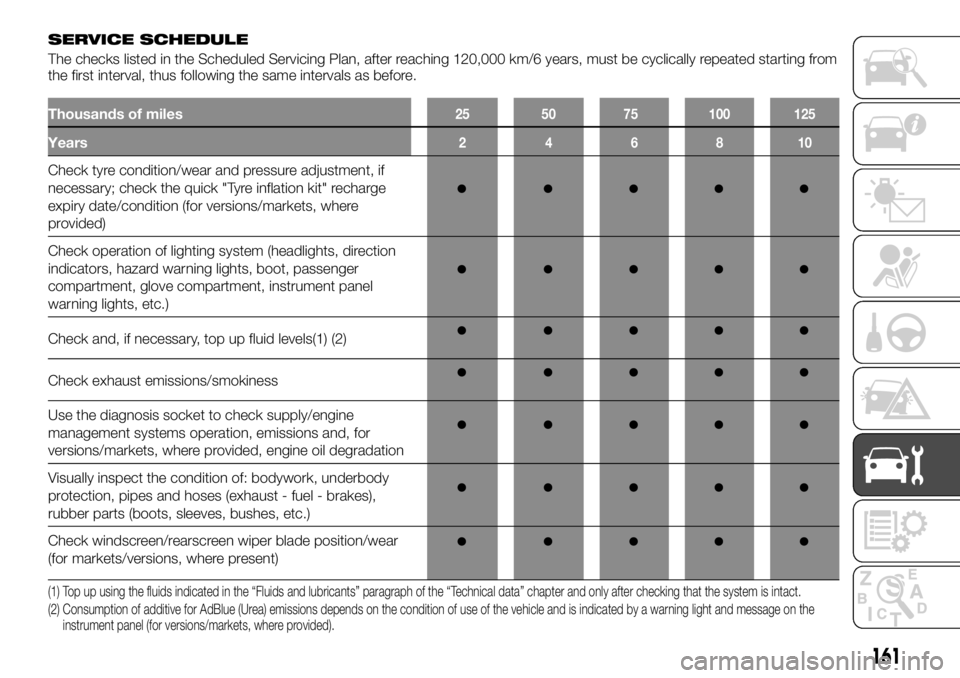
Thousands of miles25 50 75 100 125
SERVICE SCHEDULE
The checks listed in the Scheduled Servicing Plan, after reaching 120,000 km/6 years, must be cyclically repeated starting from
the first interval, thus following the same intervals as before.
Years246810
Check tyre condition/wear and pressure adjustment, if
necessary; check the quick "Tyre inflation kit" recharge
expiry date/condition (for versions/markets, where
provided)
Check operation of lighting system (headlights, direction
indicators, hazard warning lights, boot, passenger
compartment, glove compartment, instrument panel
warning lights, etc.)
Check and, if necessary, top up fluid levels(1) (2)
Check exhaust emissions/smokiness
Use the diagnosis socket to check supply/engine
management systems operation, emissions and, for
versions/markets, where provided, engine oil degradation
Visually inspect the condition of: bodywork, underbody
protection, pipes and hoses (exhaust - fuel - brakes),
rubber parts (boots, sleeves, bushes, etc.)
Check windscreen/rearscreen wiper blade position/wear
(for markets/versions, where present)
(1) Top up using the fluids indicated in the “Fluids and lubricants” paragraph of the “Technical data” chapter and only after checking that the system is intact.
(2) Consumption of additive for AdBlue (Urea) emissions depends on the condition of use of the vehicle and is indicated by a warning light and message onthe
instrument panel (for versions/markets, where provided).
161
Page 169 of 232

Unscrew cap 1 fig. 266;
restore the level (the approximate
amount to get between the dipstick 2
"min" and "max" levels is about 1.5 and
2 litres, depending on the engine);
wait about 10 seconds to let the oil
flow in the circuit;
check the level with the dipstick 2
fig. 266 (as described above).
Once the operation is done, insert the
dipstick as far as it will go or screw the
cap back on completely.
IMPORTANT To avoid splashing, use a
funnel when topping up/filling up.
IMPORTANT Never exceed the "max"
level and do not forget to put the cap
1 back on and dipstick 2 fig. 266 in
place.
188) 186) 187) 189) 190) 191) 192) 193) 194)
Change engine oil
Contact a Fiat Dealership.Amount of oil to replace
Always check the oil level with the
dipstick (it must never be below the
MIN level nor above the MAX level).
Engine oil quality
Refer to the “Fluids and lubricants”
paragraph on the “Technical data”
chapter.
IMPORTANT In case of unusual,
repeated drop, see a Fiat Dealership.
BRAKE FLUID
The level is checked with the engine
stopped and on a horizontal surface.
It has to be checked often and in any
case every time there is a minimum
variation in the braking system.
Level 2 fig. 267
The level must never drop below the
“MIN” threshold.
198) 199)
45) 49)
Filling
Every operation on the hydraulic circuit
involves replacing the fluid by a
specialised technician.
Use an approved fluid only (taken from
a new pack).
Replacement of
Refer to the Scheduled Service Plan (in
this chapter).
IMPORTANT In case of unusual,
repeated drop, see a Fiat Dealership.
COOLANT LIQUID
With the engine off, on a level surface,
the cold level should be between "MIN"
and "MAX" indicated on tank 1 fig. 268.
IMPORTANT In case of unusual,
repeated drop, see a Fiat Dealership.
188) 189) 191) 192) 193) 195)
45) 48)
266T36610
267T36609
268T36608
167
Page 174 of 232

Label A fig. 274
To read it open the driver's door
fig. 275.
B: front tyre inflation pressure when
not driving on a highway, or when there
are fewer than four people on board.
C: rear tyre pressure inflation when
not driving on a highway, or when there
are fewer than four people on board.
D: pressure inflation for front tyres
when travelling on a highway or when
there is a significant load.
E: pressure inflation for rear tyres
when travelling on a highway or when
there is a significant load.
IMPORTANT For cars used at full load
(Maximum Authorised Mass) and with a
tow trailer, the maximum speed must
not exceed 100 km/h and the tyre
pressure must be increased by 0.2 bar.
Refer to the “Weights” paragraph on
the “Technical data” chapter.Risk of
tyres bursting.
SPARE TYRE
Please see the paragraph "Replacing a
tyre" in the "Emergency" chapter.
SUGGESTIONS ABOUT
THE ROTATION OF THE
TYRES
We advise you not to do this kind of
operation.
WINTER USE
55) 56) 57) 58)
Chains
For safety reasons, mounting snow
chains on the rear axle is prohibited.
The use of larger sized tyres than the
original ones makes fitting chains
impossible.Snow tyres
We advise you to fit these tyres to
guarantee the best vehicle grip
possible.
IMPORTANT These tyres sometimes
mean a maximum speed limit that may
be less than vehicle’s maximum speed.
Studded tyres
(For versions/markets where provided)
This type of tyre can only be used for a
limited period determined by local laws.
You need to respect the speed limits
imposed by local laws in effect.
These tyres can be fitted on at least
both front wheels.
In any case, it is advisable to
contact a Fiat Dealership.
WARNING
206)Insufficient pressure can cause the
tyres to wear early and heat up abnormally,
with obvious consequences for safety;
poor road grip, risk of blow-out or treads
detaching. Inflation pressure depends on
the load and the speed. Adjust the
pressure according to the conditions of
use (see the label located on the inside of
the driver's door pillar).
207)For safety reasons, only a specialised
technician should carry out this operation.
Fitting a different type of tyre can alter the
vehicle's compliance with the regulations in
force, cornering performance, steering and
fitting snow chains.
274T36619
275T36615
172
SERVICING AND CARE
Page 180 of 232
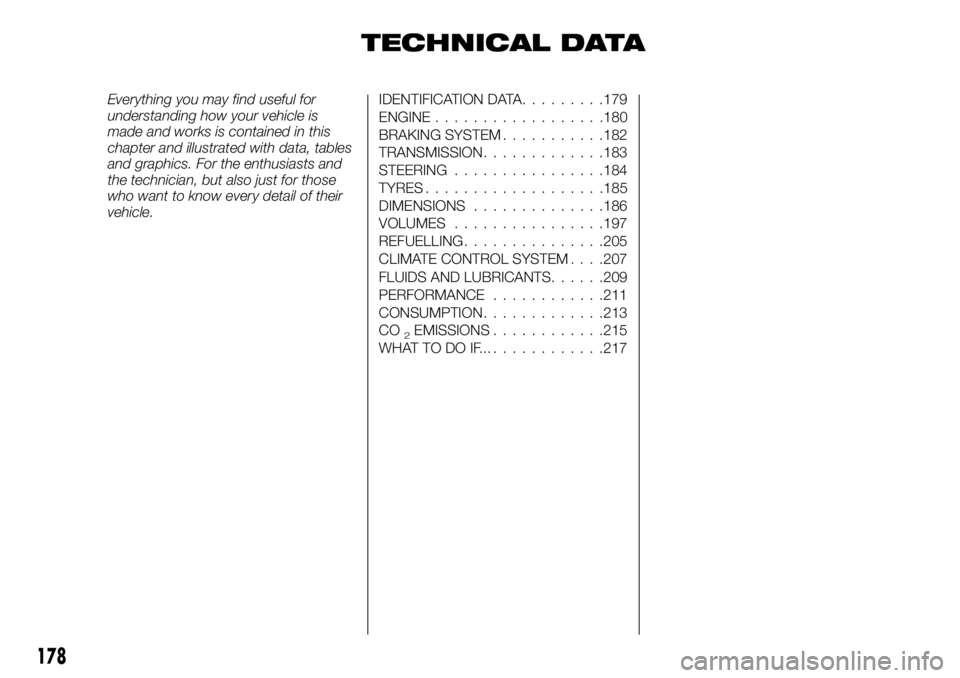
TECHNICAL DATA
Everything you may find useful for
understanding how your vehicle is
made and works is contained in this
chapter and illustrated with data, tables
and graphics. For the enthusiasts and
the technician, but also just for those
who want to know every detail of their
vehicle.IDENTIFICATION DATA.........179
ENGINE..................180
BRAKING SYSTEM...........182
TRANSMISSION.............183
STEERING................184
TYRES...................185
DIMENSIONS..............186
VOLUMES................197
REFUELLING...............205
CLIMATE CONTROL SYSTEM. . . .207
FLUIDS AND LUBRICANTS......209
PERFORMANCE............211
CONSUMPTION.............213
CO
2EMISSIONS............215
WHATTODOIF...............217
178
Page 182 of 232
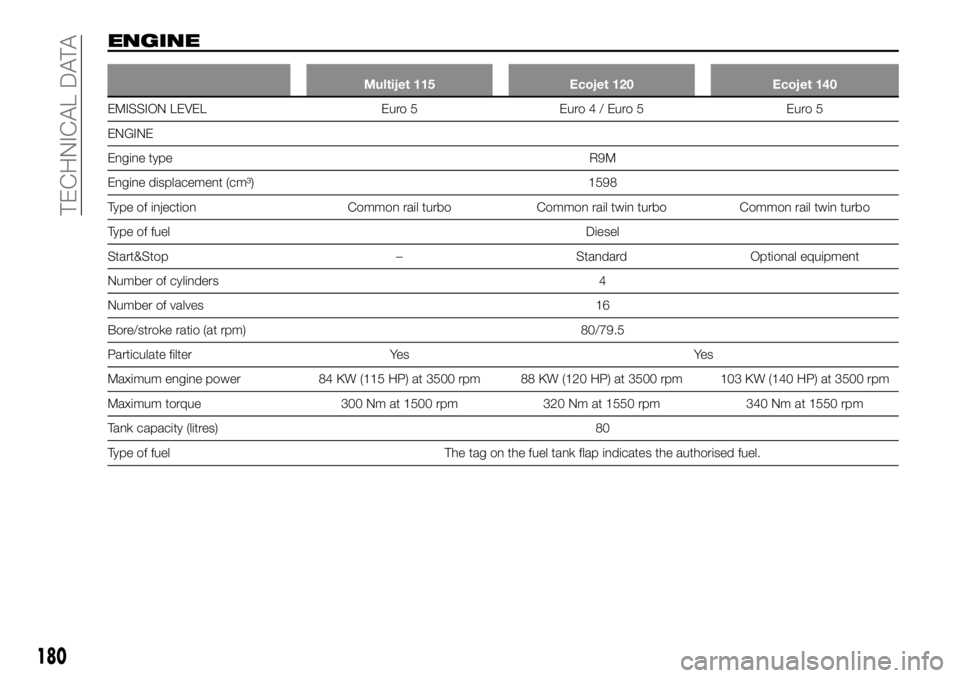
ENGINE
Multijet 115 Ecojet 120 Ecojet 140
EMISSION LEVEL Euro 5 Euro4/Euro5 Euro5
ENGINE
Engine typeR9M
Engine displacement (cm³) 1598
Type of injection Common rail turbo Common rail twin turbo Common rail twin turbo
Type of fuelDiesel
Start&Stop – Standard Optional equipment
Number of cylinders 4
Number of valves 16
Bore/stroke ratio (at rpm) 80/79.5
Particulate filter Yes Yes
Maximum engine power 84 KW (115 HP) at 3500 rpm 88 KW (120 HP) at 3500 rpm 103 KW (140 HP) at 3500 rpm
Maximum torque 300 Nm at 1500 rpm 320 Nm at 1550 rpm 340 Nm at 1550 rpm
Tank capacity (litres) 80
Type of fuel The tag on the fuel tank flap indicates the authorised fuel.
180
TECHNICAL DATA
Page 184 of 232

BRAKING SYSTEM
Multijet (Euro 5 – Euro 6) Ecojet (Euro 5 – Euro 6)
Front: 296 x 28 Ventilated
Rear:280×12
182
TECHNICAL DATA